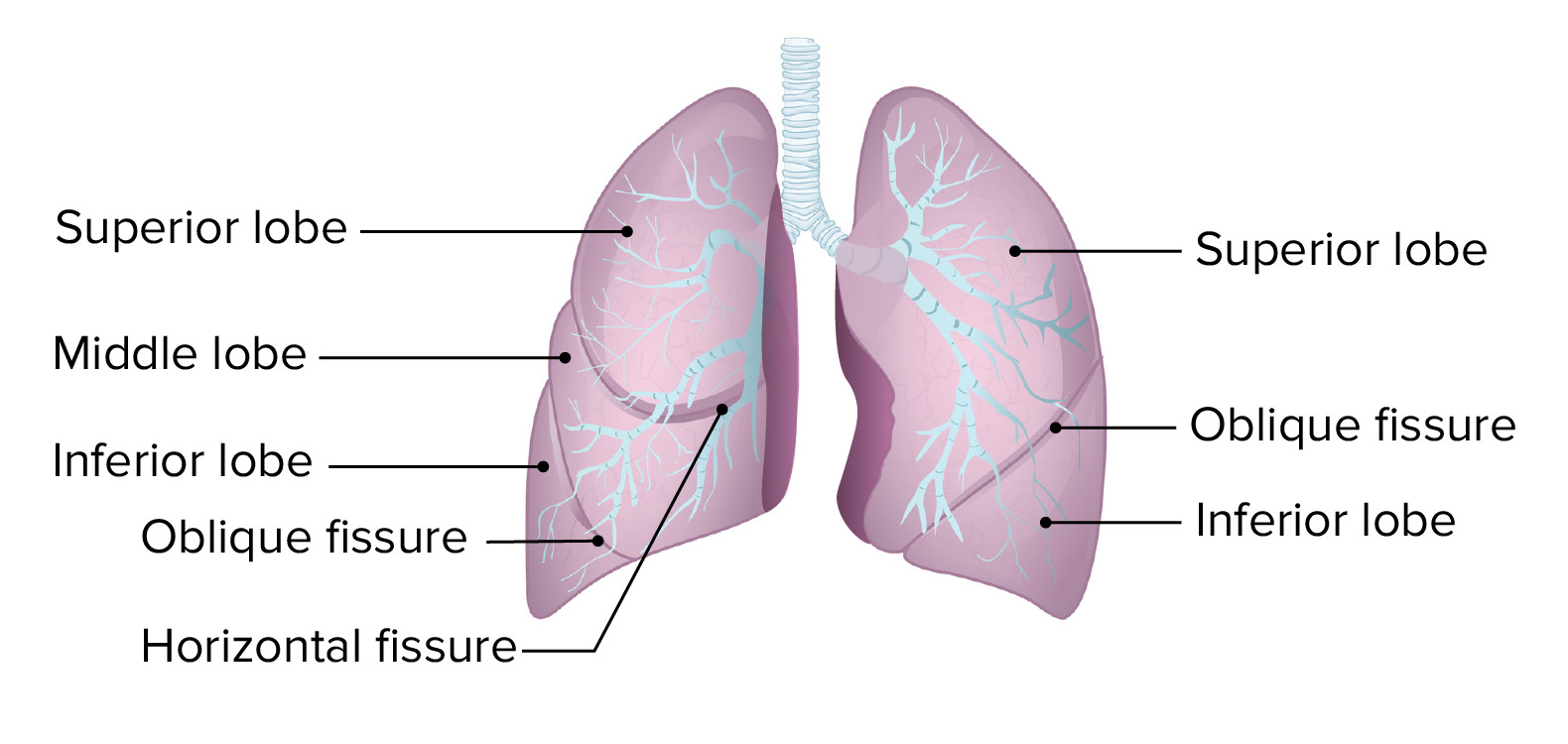Playlist
Show Playlist
Hide Playlist
Lung
00:00 from this goes for the middle mediastinum. Finally, the lung surface markings you don’t have to remember, but you need to know that there are three lobes on the right, upper lobe and middle lobe, and two lobes on the left. So, one fissure on the left and two fissures on the right. What are the two fissures on the right? Oblique and horizontal. Oblique, and here? Just the oblique fissure. 00:28 On the right, you have the horizontal fissure and oblique fissure. Surface marking you don’t have to know because normally when we do surface marking, we say that the lung is two intercostal spaces above the pleura. So, it lies so close to the lung, all the way up to the sixth intercostal space, here. From the sixth intercostal space onwards, it is two vertebral spaces away from the pleura. That’s all you need to remember but I don’t think you are going to get that in the exam. So is it the horizontal fissure you can see on the chest X-ray? Honestly, I’m confused about what that line -- The horizontal fissure, yeah. In the exam, they’re not going to ask us about little intricate bronchopulmonary segments, are they? I would say that is one of those 10% things you can’t really -- they can ask. The syllabus is so vast. 01:28 They can ask about that. They can ask about the liver lobes as well. 01:31 So in theory, they can ask about the ten bronchopulmonary segments on the right and the ten on the left, but not commonly asked, no. Let me see. What else were you asking? I’m asking about horizontal fissure. Horizontal fissure, okay. So, the lung here, that’s the pleura going this way. The lung is all the way, adhere into the pleura all the way up to the sixth intercostal space. But when it comes here, it goes a bit this way. That is your two vertebral spaces. Now, the easiest way to remember your the fissures, in the exam. This is essentially T3 vertebral level. 02:48 That’s the middle border of the scapula. If you draw a line from that vertebral level to the middle border of the scapula, coming all the way up to the sixth intercostal space, that is your oblique fissure. The same thing happens on the left as well. That is your oblique fissure. So, what do you see here? That’s oblique fissure. 03:10 The horizontal fissure is from the fourth intercostal somewhere there, which cuts across the midaxillary line. So this is what you’re seeing in the X-ray. So that is your upper lobe, middle lobe, and lower lobe. This is your midaxillary line. So that long thoracic nerve lies in the midaxillary line here, and the safe triangle for chest drain insertion is bounded by the pectoralis major muscle anteriorly, the long thoracic nerve posteriorly, and the sixth rib inferiorly. So this is part of the safe triangle. This is where you go for chest drain.
About the Lecture
The lecture Lung by Stuart Enoch, PhD is from the course Thorax Anatomy.
Included Quiz Questions
At which anatomical landmark can the birfucation of the trachea be found?
- Angle of Louis
- Mandible
- Cricoid process
- Fifth rib
A 30-year-old butcher accidentally dropped a knife onto his chest inferior to his lateral clavicle. He began bleeding profusely from his superior thoracic artery. Which of the following structures is the superior thoracic artery a branch of?
- Axillary artery
- Coronary artery
- Celiac artery
- Pulmonary artery
A 16-year-old female was riding her bike when she crashed into a tree which injured her chest. She was sent to the ER for coughing up blood and shortness of breath. Upon imaging, her left lung hilum was found to be damaged. Which of the following structures, in order, was most likely to be damaged in the left hilum?
- Pulmonary artery, Bronchus and Pulmonary vein
- Bronchus, Pulmonary artery, pulmonary vein
- Bronchus, Pulmonary vein, Pulmonary artery
- Pulmonary artery, Pulmonary vein, Bronchus
A 50-year-old male came into the office due to severe abdominal pain and distention as well as acid reflux. Imaging shows disruption of a certan structure surrounded by the left and right vagus. This structure can be found in which compartment of the body?
- Posterior mediastinum
- Anterior mediastinum
- Medial mediastinum
The structure known as ____ separates the left upper lung from the left lower lung.
- Oblique Fissure
- Horizontal Fissure
- Lateral Fissure
- Vertical Fissure
Customer reviews
5,0 of 5 stars
| 5 Stars |
|
2 |
| 4 Stars |
|
0 |
| 3 Stars |
|
0 |
| 2 Stars |
|
0 |
| 1 Star |
|
0 |
easy explained and understandable. nice mnemonics and just wonderful. thank you very much professor.
Short and sweet in easily understandable way ...worth in time and knowledge




